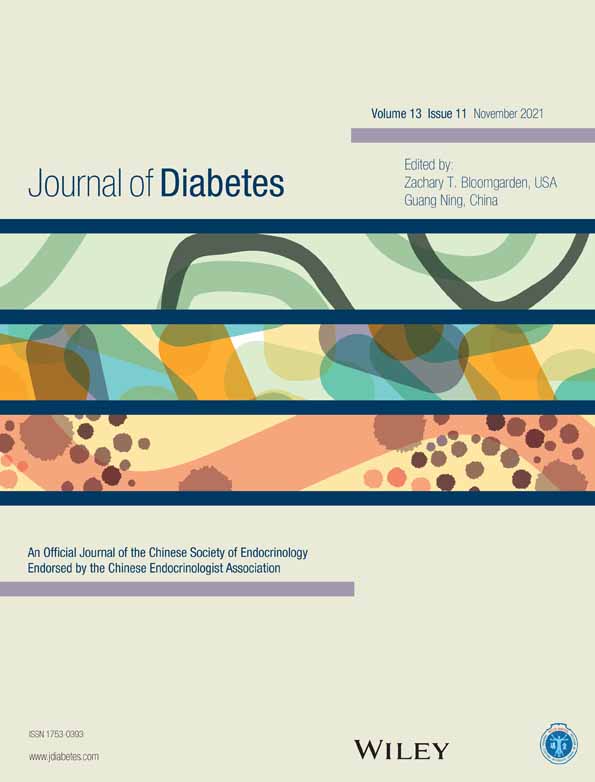The association of energy and macronutrient intake at dinner vs breakfast with the incidence of type 2 diabetes mellitus in a cohort study: The China Health and Nutrition Survey, 1997-2011
晚餐与早餐能量和宏量营养素摄入与2型糖尿病发病率的关系研究:1997-2011年中国健康与营养调查
Funding information: Tianshu Han, Grant/Award Numbers: The National Natural Science Foundation (81803227), Young Elite Scientists Sponsorship Program by CAST; Changhao Sun, Grant/Award Number: National Key R&D Program of China (2017YFC1307401)
Abstract
enBackground
This study aims to investigate the association of energy and macronutrient intake at dinner vs breakfast with the incidence of type 2 diabetes mellitus (T2DM).
Methods
A total of 11 153 adults, including 811 with T2DM, completed a questionnaire about energy and macronutrient intake in the China Health and Nutrition Survey (1997-2011). The differences (Δ) in energy and macronutrient intake between dinner and breakfast (Δ = dinner − breakfast) were categorized into quintiles. Cox proportional hazards regression models were performed to explore the association between Δ and the risk of T2DM and to investigate the change of the risk when 5% total energy or energy provided by macronutrients at dinner was substituted with total energy or energy provided by macronutrients at breakfast by isocaloric substitution models.
Results
After adjustment for potential confounders, compared with participants in the lowest quintile, participants in the highest quintile were more likely to develop T2DM (hazard ratio [HR]Δenergy 1.46, 95% CI 1.13-1.87; HRΔfat 1.85, 95% CI 1.43-2.41; HRΔprotein 1.37, 95% CI 1.06-1.78). Isocalorically replacing 5% energy at dinner with energy at breakfast was associated with a 7% lower T2DM risk. Replacing 5% energy provided by fat at dinner with energy provided by carbohydrate, protein, and fat at breakfast was associated with a 9%, 5%, and 7% lower T2DM risk, respectively. Replacing 5% energy provided by protein at dinner with energy provided by carbohydrate or protein at breakfast was associated with a 5% lower T2DM risk.
Conclusions
Higher intake of energy, protein, and fat at dinner than at breakfast increased the risk of T2DM.
摘要
zh目的
本研究旨在调查晚餐和早餐能量和宏量营养素摄入与2型糖尿病发病关系。
方法
本研究共纳入在1997-2011年中国健康与营养调查中完成了能量和宏量营养素摄入问卷调查共计11153名成年人, 其中包括811名2型糖尿病患者。将晚餐与早餐能量或宏量营养素摄入量的差值(Δ)五分位数后, 利用Cox比例风险回归模型探讨Δ和2型糖尿病的风险。利用等能量膳食替代模型探讨在每日总能量不变的情况下, 当晚餐中总能量或宏量营养素提供能量的5%被早餐能量或宏量营养素提供的能量所替代时2型糖尿病发病风险的改变。
结果
在对潜在混杂因素进行校正后, 与晚餐和早餐能量, 脂肪和蛋白质Δ值处于最低分位的参与者相比, 当Δ值处于较高分位时, 可能会增加2型糖尿病患的发病风险(风险比HRΔenergy 1.46, 95% CI: 1.13-1.87;HRΔfat 1.85, 95% CI:1.43-2.41;HRΔprotein 1.37, 95% CI:1.06-1.78)。在每日总能量摄入不变的情况下, 当晚餐摄入能量的5%被早餐所替代时, 2型糖尿病患的发病风险降低7%。当晚餐脂肪提供的能量的5%被早餐碳水化合物, 蛋白质和脂肪提供的能量所替代时, 2型糖尿病的发病风险降低分别降低9%, 5%和7%。当晚餐蛋白质提供的能量的5%被早餐碳水化合物或蛋白质提供的能量代替时, 2型糖尿病的发病风险降低5%。
结论
晚餐比早餐摄入更多的能量, 蛋白质和脂肪会增加2型糖尿病发病风险。
CONFLICT OF INTEREST
The authors declare no conflict of interest.




